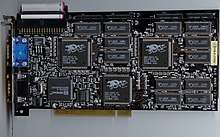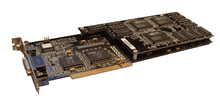Scan-Line Interleave
Scan-Line Interleave (SLI) from 3dfx is a method for linking two (or more) video cards or chips together to produce a single output. It is an application of parallel processing for computer graphics, meant to increase the processing power available for graphics. SLI from 3dfx was introduced in 1998 and used in the Voodoo2 line of graphics accelerators. However, the original Voodoo Graphics card and the VSA-100 were also SLI-capable.

Nvidia Corporation reintroduced the SLI acronym in 2004 (though it now stands for Scalable Link Interface) and intends for it to be used in modern computer systems based on the PCI Express bus.
Function

3dfx's SLI design was the first attempt, in the consumer PC market, at combining the rendering power of two video cards. The two 3dfx cards were connected by a small ribbon cable inside the PC. This cable shared graphics and synchronization information between the cards. Each 3dfx card rendered alternating horizontal lines of pixels composing a frame.
Criticism
3dfx incorporated the notion of adding an extra video card into its already (relatively) extensive advertising campaigns. Advertisements in various video gaming magazines had contained such quotes as "double the hardware, double the power", or "Twice as fast". Although many believed that adding another expensive card would double frame-rates, this proved not to be the case.[1][2]
Aside from this, successfully running the SLI configuration often proved difficult. At the time (as the case with the Voodoo2), some motherboards would not function with three video cards installed (i.e. 2D card, Voodoo2 #1 and Voodoo2 #2). In other cases, there were issues with conflicts as system resources in normal ranges were already accounted for, partly because many features that are today integrated into motherboards (such as the network interface and sound playback facilities) were at that time provided by add-on cards, each requiring additional system resources. Some systems lacked enough open PCI slots to support the setup and additional add-on cards were sometimes sacrificed.
If the technical issues were surmounted, it was further discovered that some applications had problems operating under SLI. Furthermore, those programs that did function sometimes experienced tearing and other display artifacts resulting in a growing number of dissatisfied enthusiasts. Still, a number of fans touted SLI as the future of gaming and as such, SLI became more of a status symbol than a viable system upgrade.
By the time that the setup was cost-effective, there were single card solutions that rivaled the theoretical capabilities of the SLI configuration, for lower costs. As a result, SLI received little market presence, although many gamers still consider the 3dfx SLI setup to have been "the" setup to have for hardcore gaming. Although the performance benefit is not always obvious, it did allow higher resolution support of up to 1024x768 compared to 800x600 offered by a single card.
See also
- Scalable Link Interface
- AMD CrossFireX